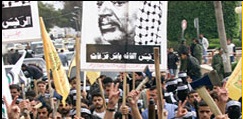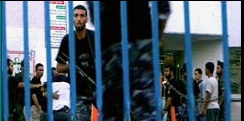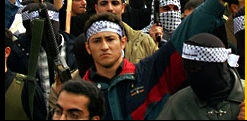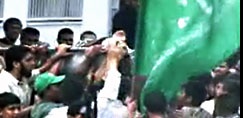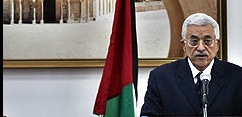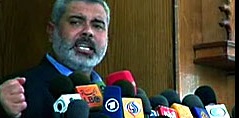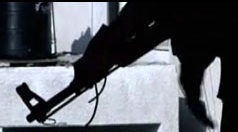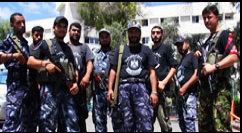Fatah vs. Hamas
The divisions between the two main Palestinian political factions, Fatah and Hamas, are not religious – as nearly all Palestinian Muslims are from the Sunni branch of Islam – but rather ideological differences in objectives, governance, and relations with Israel. Tensions between Fatah and Hamas began to rise in 2005 after the death of the charismatic leader Yasser Arafat. After Hamas’s parliamentary election victory in January 2006, relations were marked by sporadic factional fighting and several assassinations of both Hamas and Fatah leaders. The conflict grew more intense after the two parties repeatedly failed to reach a deal to share government power, escalating in June 2007 into an outright civil war. As of August 2007, the Palestinian Territories are split into a Hamas-controlled Gaza Strip and a Fatah-dominated West Bank.
Brief History:
FATAH
Fatah, which means ‘conquest’ in Arabic, is a reverse acronym of Harakat al-Tahrir al-Filistinya (Palestinian Liberation Movement).
Fatah is a secularist group and was founded by Yasser Arafat and a handful of close comrades in the late 1950s to promote the armed struggle to liberate all Palestine from Israeli control.
According to the BBC, “Arafat took over as chairman of the executive committee of the Palestinian Liberation Organization (PLO) in 1969, a year that Fatah is reported to have carried out 2,432 guerrilla attacks on Israel.” Upon joining the PLO – a confederation of secular Palestinian parties – Fatah went from being a resistance group to a legitimate political party and the largest faction within the PLO. As a result, Fatah is no longer considered a terrorist organization by the United States, although it is associated with militant wings responsible for inciting violence against Israel and other Palestinians.
Under the Oslo peace accords, after recognizing Israel’s right to exist in 1993, Fatah led efforts toward a two-state solution with Israel. These meetings established the Palestinian Authority (PA), headed by Arafat’s Fatah party.
The peace accords were unsuccessful and, in 2002, Fatah began to lose the support of the Palestinian people. The biggest blow to the party was Arafat’s death in 2004. A rift between the “old guard” and the “new guard” steadily eroded its power, and Palestinians increasingly viewed Fatah as a corrupt, Western-supported government that did not serve its people adequately. After 40 years as the ruling Palestinian party, Fatah lost its majority to Hamas in the 2006 parliamentary elections, winning just 43 out of 132 seats.
In June 2007, Hamas seized control of the Gaza Strip following days of deadly infighting between the two factions. Arafat’s successor, President Mahmoud Abbas of Fatah, declared a state of emergency in the Palestinian Territories. After firing all Hamas government officials, Abbas created a Fatah-led emergency government. As of August 2007, Fatah retains control of the West Bank and is renewing negotiations with Israel.
HAMAS
Hamas, which means ‘zeal’ in Arabic, is an acronym for Harakat al-Muqawama al-Islamiya (Islamic Resistance Movement).
Hamas is an Islamist militant group which began as the Palestinian branch of the Muslim Brotherhood, an Islamist organization based in Egypt.
Established by the late Sheikh Ahmed Yassin in 1987 after the first intifada (Palestinian uprising against Israel), Hamas follows the Brotherhood’s two pronged approach of armed resistance and social welfare. Hamas is designated as a terrorist group by the United States government due to its long history of suicide bombings and attacks on Israel: since its first attack in 1993, more than 500 people have been killed by Hamas attacks.
In addition to its militancy, Hamas oversees an extensive network of social services in the Palestinian Territories, funding education, healthcare, soup kitchens, and mosques.
The group’s popularity is relatively recent and has grown (with fluctuations) as Fatah’s has declined. However, even after Arafat’s death, only 18.6 percent of Palestinians named Hamas as the faction they trusted the most. In 2004 and 2005, Hamas participated in the political process for the first time and won significant representation during the municipal elections.
Few expected the overwhelming election victory of the following year: in January 2006 it secured 76 out of 132 seats in the Parliament. This not only pushed the increasingly unpopular Fatah party into second place, but also triggered a crippling Western economic boycott. The United States and the European Union withdrew over $1 billion in foreign aid when Hamas refused to renounce violence and recognize Israel’s right to exist.
Factional fighting between Hamas and Fatah fighters, along with repeated failures to reach a unity government, escalated to outright civil war in the Gaza Strip in June 2007. Hamas took complete control of the Gaza Strip and former Prime Minster Ismael Haniyeh of Hamas declared himself head of a new Gaza Strip government. As of August 2007, Hamas is more isolated than ever.
Objectives
FATAH
Both Fatah’s and the PLO’s original political charters called for “the end of the Zionist presence” in Palestine. Until 1993, Fatah openly sanctioned violence against Israel as a means to achieve a Palestinian state. With the signing of the Oslo accords that year, Arafat had to moderate the party line.
After recognizing Israel’s right to exist, and creating the Palestinian Authority (PA) in 1993, the PLO’s official charter was updated to reflect the new stance. In a letter to President Clinton in 1998, Arafat confirmed that “the provisions of the Covenant which are inconsistent with the PLO commitment to recognize and live in peace side by side with Israel are no longer in effect.” However, despite his official statements, Arafat did little to prevent attacks on Israel.
In 2002, under tremendous pressure, Arafat found a compromise and publicly condemned new attacks on Israeli citizens (to not dishonor the men who had already died in suicide bombings) — yet maintained that armed resistance within the Palestinian Territories was legitimate.
As of August 2007, Fatah officially supports a two-state solution that would lead to an Israeli state and a Palestinian state (comprised of the Gaza Strip, the West Bank, and parts of Jerusalem). The group speaks out against armed resistance and attacks on Israeli civilians, but still maintains its association with armed militant factions.
HAMAS
Hamas’s founding document, drafted in 1988, states the group’s Islamist credo: “The Islamic Resistance Movement is a distinct Palestinian Movement which owes its loyalty to Allah, derives from Islam its way of life and strives to raise the banner of Allah over every inch of Palestine.” (Article 6)
The document also disregards peaceful alternatives to armed struggle: “Initiatives, and so-called peaceful solutions and international conferences, are in contradiction to the principles of the Islamic Resistance Movement.”
The charter also explains that Hamas uncompromisingly seeks the destruction of Israel, pursuing a Palestinian state that encompasses the Gaza Strip, the West Bank, all of Jerusalem, and Israel: “Israel will exist and will continue to exist until Islam will obliterate it, just as it obliterated others before it.”
Hamas officially rejects the peace process with Israel, however lately has shown signs of moving towards a moderate stance. In mid-June 2007, Reuters reported that former Prime Minister Ismael Haniyeh and Hamas were open to a “long-term” truce with Israel if Israel returns to its pre-1967 borders and allows a viable Palestinian state to emerge.
Political Leadership
FATAH
Yasser Arafat Yasser Arafat was one of the founders of Fatah and the Chairman of the Palestine Liberation Organization (1968-2004) and the Palestinian National Authority (1993-2004). In 1994, Arafat received the Nobel Peace Prize together with Israel’s Yitzhak Rabin and Shimon Peres, for the negotiation of the 1993 Oslo Peace Accord. Throughout his long career and until his death in November 2004, Arafat was both a controversial and controlling figure. For some, he was a heroic freedom fighter who symbolized the plight and national aspirations of the Palestinian people; for others, he was an unrepentant terrorist.
Mahmoud Abbas President Mahmoud Abbas was among the founding members of Yasser Arafat’s Fatah party. The Council of Foreign Relations describes him as “more moderate than Arafat” and, as of 2005, “the most influential Palestinian political figure.” In 1980 Abbas became head of the PLO’s international relations office. Abbas negotiated with Israel during the Oslo peace accords and accompanied Arafat to Washington to sign them in 1993. In 2005, Mahmoud Abbas was elected President of the Palestinian Authority. Abbas also succeeded Arafat as Chairman of the PLO Executive Committee.
Salam Fayyad Upon resigning as Finance Minister, Salam Fayyad founded the Third Way political party and ran in the 2006 elections. He became the PA’s newest Prime Minister after Abbas fired all Hamas government officials, including former Prime Minister Ismael Haniyeh, during the Hamas seizure of Gaza in June 2007. Fayyad is described as politically “independent.” Aid to Palestinians from Western countries has been routed to bank accounts to which he has access.
Marwan Barghouti Marwan Barghouti is considered the leader of Fatah’s “new guard,” reformers who have openly criticized the insular, often autocratic and corrupt rule of Fatah’s founders. Barghouti is also associated with the armed militant wing, Al Aksa Martyrs Brigades. As the street leader of the second intifada (uprising), he has been extremely influential in Palestinian politics, winning a seat in parliament in 2006 while serving multiple life sentences in an Israeli jail on murder convictions stemming from his role in 2002 suicide bombings against Israelis. Many Palestinians, and even some Israelis, are calling on Israel to release him so he could possibly succeed Abbas and keep Hamas at bay.
HAMAS
Khalid Meshal Khalid Meshal leads Hamas as chief executive and political leader. Meshal, a West Bank native has been living in exile in Syria since the 1990s. He runs the organization from Damascus.
Musa Abu-Marzuq Musa Abu-Marzuq is believed to be the Deputy Political Chief of Hamas operations in Damascus, Syria. Marzuq spent many years living in Jordan and the United States (residing in Louisiana and northern Virginia) and both countries expelled him.
Ismael Haniyeh Ismael Haniyeh was Prime Minister of the Palestinian Authority until mid-June 2007, when Palestinian President Mahmoud Abbas dissolved the Palestinian government after Hamas’s seizure of the Gaza Strip. Haniyeh hails from Gaza and is widely seen as a moderate within Hamas. After Abbas fired him, Haniyeh declared himself head of a new Gaza Strip government. The parliament in Gaza has not functioned since.
Sheikh Hassan Yousef Sheik Hassan Yousef has been in charge of Hamas in the West Bank since 2001. Yousef won a parliamentary seat in the January 2006 elections even though he was jailed at the time. He has been in and out of prison over the years and is currently jailed in Israel. A briefing prepared by the US Congressional Research Service describes him as the one who “may promote moderation within Hamas.”
Said Siyam Said Siyam formerly served as Interior Minister of the Hamas government and created Hamas’ss 3,000-member strong Executive Force to police the streets of Gaza in May 2006. Sayid was replaced as a result of the short-lived Hamas-Fatah unity government formed at Mecca in February 2007, which tapped Hani al-Qawasmi for the post. Al-Qawasmi resigned shortly before Hamas seized Gaza and Abbas’s dissolved the unity government in June 2007.
Security Forces and Militant Wings
FATAH
Security forces:
Palestine Security Force:
Over the years, Yasser Arafat built an elaborate security service that consisted of about 40,000 men and a dozen different agencies. After the second intifada (Palestinian uprising that began in 2000), Israel and the US complained that Arafat did not order his security services to prevent Palestinian attacks against Israel. In May 2005, Mahmoud Abbas streamlined the security forces by installing new commanders. The reshuffle included the removal of Moussa Arafat, a cousin of Yasser Arafat. In addition, an estimated 1,000 officers who reached the age of 60 were forced to retire under a new law marking a change of direction from the rule of Yasser Arafat. Militant wings:
Numerous militant wings linked to the Fatah party have surfaced throughout the Palestinian conflict–from the 1950s, when it was founded as a military commando group by Arafat and his comrades to rally the Palestinian diaspora, through 2007, where Fatah is now an official political party unofficially associated with various militant wings.
Force 17
Force 17 began in the 1970s as a personal security force for Yasser Arafat and other PLO leaders and was involved in attacks against Israelis during the 1980s. Force 17 was merged into the official Palestinian Authority security apparatus when the PA was created in 1993. A Congressional Research Service briefing says that, with the merger, Force 17 “technically ceased to exist” but some members “continue to identify themselves as Force 17.” Recent US press reports have also mentioned its continued existence.
Fatah Hawks
Led by the popular movement of Arab Youth in the West Bank and Gaza, and key players in the first Palestinian intifada which broke out in 1987, the Fatah Hawks were eventually dissolved in 1995. Means of attack included improvised weapons, stone throwing, stabbing attacks, roadside ambushes and use of stolen firearms.
Tanzim
In 1995, the Fatah leadership instituted its own militia group, the Tanzim, as a counterweight to the military might of the home-grown militant Islamist groups Hamas and Islamic Jihad. Tanzim came to prominence in the street fighting which marked the beginning of the second Palestinian intifada. Its members tend to be younger than those of other Fatah factions, often having grown up in the post-Oslo era.
The group initially vowed to target Israeli soldiers and settlers in the West Bank and Gaza Strip, and to carry out guerrilla warfare against the Israeli military. However, in 2002, they began attacking civilians in Israeli cities and were designated a foreign terrorist group by the US.
Al-Aqsa Martyrs’ Brigade
In 2000, the second intifada saw a number of armed groups associated with Fatah and Tanzim emerge. One of the most active forces was the al-Aqsa Martyrs’ Brigade, whose membership is primarily drawn from the ranks of Tanzim. It comprises an unknown number of small cells of Fatah-affiliated activists that aim to drive the Israeli military and settlers from the West Bank, Gaza Strip, and Jerusalem, in order to establish a Palestinian state. The relationship between Al-Aqsa and Fatah has been ambiguous, with the group claiming that it is officially tied to the Fatah party, a claim consistently denied by Yasser Arafat and Mahmoud Abbas.
Al-Aqsa is a secular group that claims to seek peace with Israel, if Israel agrees to withdraw from all occupied territories and allow Palestinian right of return for displaced refugees.
Al-Aqsa is often involved in violent clashes with Hamas factions in the Gaza Strip. The US declared Al-Aqsa to be a foreign terrorist organization in March 2002 because it claimed responsibility for suicide bombings against Israeli citizens.
HAMAS
Security forces:
Hamas Executive Force: The Hamas Executive Force, officially created in May 2006 to bring order to the streets of Gaza, was estimated to have 6,000 members by mid-2007. They began as an unorganized paramilitary group that was given uniforms, trained, and then added to the Palestinian Authority’s payroll as a new security force after Hamas won political power by the ballot in the January 2006 elections. They were then used to establish complete Hamas control of Gaza by the bullet in June 2007. Later that month, President Mahmoud Abbas issued a decree outlawing the Hamas Executive Force. Despite this, the force continues to operate in the Gaza Strip.
Militant Wings: Izz ad-Din al-Qassam Brigade Izz ad-Din al- Qassam Brigade is the military wing of the Palestinian militant group Hamas. The group has approximately 7500 members and was created in 1992 to support the goals of Hamas, which included blocking the Oslo Peace Accords negotiations. From 1994 to 2000, in an attempt to block the peace process, the Izz ad-Din al-Qassam Brigades carried out a number of attacks against both Israeli soldiers and civilians, giving way to the second intifada in 2002. The group is known for its strength and sophisticated weaponry, which includes long-range “Qassam” rockets, guided anti-tank missiles, and anti-aircraft missiles.
The Brigade operated several cells in the West Bank, but most of them were destroyed by 2004 following numerous Israeli Defense Forces (IDF) operations in the region. In contrast, the Brigade retained a forceful presence in the Gaza Strip.
The Izz ad-Din al-Qassam Brigade is listed as a terrorist organization by the European Union, the United States, Australia and the United Kingdom.
Communication Channels
FATAH
The official broadcasting channel in Gaza is run by the Palestinian Broadcasting Corporation which is closely aligned with Fatah. The organization also operates the Voice of Palestine radio station and Palestine TV. These outlets came under the jurisdiction of the Palestinian president in early 2006. The move was seen as an attempt to prevent the new Hamas-dominated government from exerting control over the official media.
Since June 2006, Hamas’s control over Gaza has caused nine TV media outlets to shut down. Three of them are state-owned: the Public Broadcasting Corporation (an unofficial Fatah affiliate), the Voice of Palestine radio, and the WAFA news agency. The other six are privately owned affiliates of Fatah. In order to reach a wider audience with their message, the Palestine Broadcasting Corporation (PBC) is distributing its content with an internet broadcast partner, Jump TV.
Websites:
* Fatah’s Intellectual office website
* Al-Krama Newspaper (Fatah’s PR Office)
* http://www.jumptv.com/en/channel/palestinetv/
HAMAS
The majority of media outlets in Palestine are based in the Gaza Strip. Since June 2007, Hamas loyalists have either shut down or assumed control of these outlets. As of August 2007, only two TV stations are currently available: Hamas’sss Al Aqsa and the Islamic Jihad’s Sawt Al Aqsa, and two radio stations: Al Qur-an Al-Kareem which is run by Hamas’ss Religious Affairs ministry, and Radio Alwan which is considered a pro-Hamas station.
Hamas has a large online presence and has seven leading websites that target an audience beyond the estimated 243,000 Palestinians with internet access, with its official website being served in a variety of languages including Arabic, Russian, French, Farsi, Urdu, and English. Hamas also has an online children’s magazine, which launched in 2002. The site features comics, poems, entertainment and stories celebrating the heroism of the shaheeds (martyrs for the sake of Allah).
Websites:
SOURCES:
BBC, New York Times, Council on Foreign Relations, National Public Radio, Gazette (Montreal), The Guardian, US Congressional Research Service (CRS), Journal of Palestine Studies.www.jstor.org

